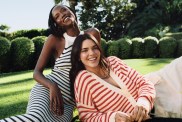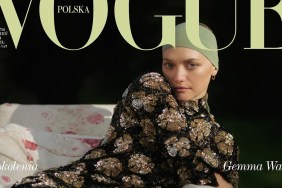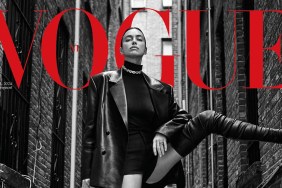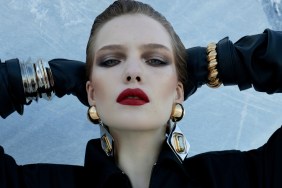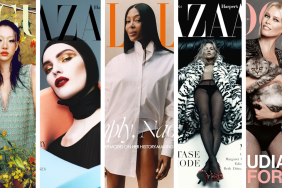Everything must change, nothing stays the same – or so the Donny Hathaway lyric goes. And though the faces of models change with each new collection, supermodels Naomi Campbell, Kristen McMenamy, and Jenny Shimizu still lend their faces and bodies to glossy editorials and runways, while most of their contemporaries have closed shop and quietly opened restaurants, or moved on to other opportunities outside of the fashion industry.



Coco Mitchell: No, I was not always interested in fashion. Though I am originally from Tampa, Florida, my family moved to NYC when I was five after my father passed away. My mom was a single parent, so the most important thing in my working class background was getting in education and being a professional. The creative arts were not a part of the landscape, so I graduated from the City College of New York with a BS in Education.
tFS: How did you transition from education to modeling?
Coco Mitchell: I was walking down Fifth Avenue after having just left a job interview to teach at a parochial school. I ran into Eileen Ford from Ford Modeling Agency. Eileen thought I was a model, and asked if I had a book. I told her that I had lots of books because I was going to be a teacher. [Lots of laughter] The only thing I knew about modeling was Beverly Johnson on the cover of Vogue in 1973. What was important to me at that time was having the basics and being able to support myself. Modeling was not on my radar.
Eileen Ford thought I should be modeling and not teaching small children. Initially, I was insulted because I had gone to college for four years to learn my profession, and this woman was trying to diminish my efforts. Eileen Ford gave me a card and asked me how much I was going to make as a teacher. I told her $227 every two weeks. She smirked, and told me I could make that much every 15 minutes modeling. Anyway, I took her card and kind of forgot about it. I taught school for one year, and though I loved teaching, the salary was not enough to comfortably live on.
Eventually, I gave Eileen Ford a call and she signed me. Immediately, I started working for Mademoiselle and Glamour because I had the right look.

Coco Mitchell: Though I was striking, my look was not imposing. You have to understand that in 1975, there were only two African American top models, Pat Cleveland and Beverly Johnson, and my look was not outside of what the industry understood beauty to be at that time.
tFS: Were you only doing print at that time?
Coco Mitchell: Yes, only print. Although I was making great money and booking lots of jobs, I was still flying by the seat of my pants, so to speak. Remember, I didn’t know how to model, or knew anything about the industry. I would walk down Fifth Avenue and copy the poses of the mannequins in the windows, and bring those poses to the set.
Most people don’t realize that modeling is tough. They only see the glamour. They don’t realize that you are going on go-sees and shooting layouts and editorials in all types of weather.
After a year of doing print work in NYC, I decided I wanted to continue modeling, but in a warmer climate. I had worked for Glamour and Mademoiselle, and I had shot this incredible campaign with Iman and Tamara Dobson for a product called Polished Ambers, the first Revlon cosmetics line made for black women, shot by Francesco Scavullo. In a nutshell, NYC had been my training ground and prepared me to work in other cities.
So, I moved to Los Angeles and worked as a print model there. Now, L.A. is not NYC, but I worked with great photographers like Herb Ritts and Matthew Rolston, and I did a campaign for Maybelline while I was in L.A.
tFS: You went from being a top print model in L.A. to working in Italy. How did all that happen?
Coco Mitchell: My agent sent me to a casting with this Italian agent who was casting for print work in Italy. Though I was still very much an L.A. print model – I walked around in tank tops and sandals – I booked the job, I started working in Florence with the photographer Aldo Fallai, and he shot a lot of the campaigns for Italian magazines and designers. I also did catalog work for Ferragamo, Gucci, Versace and several other Italian designers.
tFS: When did you start runway modeling?
Coco Mitchell: I had worked in Florence for about a year, and everyone was telling me I should go work in Milan. Now, Florence is very laid back, and I was making good money and living a fierce life there. The life was good, the gifts were good and the men were incredible. Why would I want to give that up?
Anyway, my agent took me to Milan to meet Riccardo Guy, one of the biggest agents in Milan, at that time. Riccardo Guy liked me and sent me to a casting with Giorgio Armani. Armani asks me if could walk, and I thought he was crazy because of course I can walk, everybody who is not disabled, can walk. Remember, I was a print model and had never done runway, and knew next to nothing about runway. Anyway, I walked nonchalantly across the room. Armani in disgust called my agent and complained about my walk. My agent got on the phone and told me that Armani thought I was crazy because I was walking like I didn’t care if I got the job. I got on the phone with my agent and he told me to walk very elegantly, as though I had on an expensive suit, with gloves and a fur stole to match. So, I stood tall and walked again for Armani. Armani booked me for three shows, and I was paid $5000 for each show. That season I faked it, and booked 25 shows, not knowing a thing. And, Armani told me I was the best runway model in the world!!
tFS: How did you start collaborating with Patrick Kelly?
Coco Mitchell: My agent in Milan sent me and another model to do runway work in Paris. This was my first season in Paris and I was at dinner with Iman, Janice Dickinson, and some other top models. The restaurant later in the evening turned into a nightclub, and as I was dancing, Patrick came up to me and said in this thick southern accent, “Coco, child, you are going to model my clothes.” At the time I didn’t know who he was, so I didn’t take him seriously.
The next season in Paris, my luggage was lost, and someone told me that Patrick could help me out. Remember, I had met Patrick all of one time. Patrick was so gracious to me. He cut out patterns on the floor and made me seven dresses to wear to my go-sees.
tFS: Were you Patrick Kelly’s muse?
Coco Mitchell: No, Patrick didn’t have a muse. The muse was in his head. When he got the backing from Warnaco, he needed top models to show off his clothes in his atelier to press and buyers. I was one of those models.
The American buyers and press didn’t know that Patrick was black. He did these unconventional things, like serving fried chicken and collard greens in his atelier. His charm and grace were infectious.
tFS: You are a part of an era where there were a substantial amount of black models on the runway – Iman, Mounia, Beverly Peele, Veronica Webb, Naomi – did that also apply to print?
Coco Mitchell: In the 80’s, African American models got print campaigns and runway in Europe, but mostly runway work in America. And to be fair, I made my career in Europe, so I know more about that market. I did walk in shows in the U.S., but that was later, and I was usually cast based on my reputation in Europe.
In Europe, the fittings are different, and you have to come dressed with make-up on for go-sees, not this clean, scrubbed face look. You had to look the part and know what each designer liked, know how to walk for each designer.
tFS: What was that time like?
Coco Mitchell: It was unreal – you are flying on private jets, you go to Valentino’s palazzo after a show to eat and sip champagne. But not everyone was a part of the inner circle, or as the French would call it, the cabine. Some American girls never acclimated themselves to Europe and the lifestyle, so they just modeled clothes but did not enjoy the perks.
tFS: Who were some of the designers that you’ve worked with?
Coco Mitchell: Thierry Mugler was a favorite of mine, because not only did I model his clothes on the runway, I also did his print campaigns. I did a campaign for Mugler with Djimon Hounsou in White Sands, New Mexico on top of the white sands.
Jean Franco Ferre was so masterful with construction and design. He was not a big talker, but he knew exactly what he wanted.
Yves St. Laurent was a little scary to work with. He was very distant, so you didn’t have much contact with him. There were lots of walls up.
Givenchy was such a gentle, refined man, as was Armani. If you wanted to be in the company of these great designers, you had to have curiosity and be classy.
tFS: What is your greatest quality?
Coco Mitchell: My greatest quality then and now is that I don’t have a fear of someone not liking me. I was always prepared, and did my best. Sometimes your best is not what a client wants, so you move on to the next project.
tFS: Coco, you are still modeling and involved in fashion. How have you kept the momentum going?
Coco Mitchell: After working for over 35 years in the industry, I realized that the collaborative process is very important. I am not a hired hand for a company or an individual – we collaborate ideas and work on projects together. And that concept has kept me working and still relevant in the industry. At this point in my career, I am choosing the things that I want to do.
tFS: And what are you choosing to do?
Coco Mitchell: I am choosing to mentor and work with young models. I am teaching the art of charm to people who are trying to assimilate themselves into society. My work now lies with helping young people in the industry achieve their dreams and find quality in their lives.
Editorial photos courtesy of Rick Louis.




